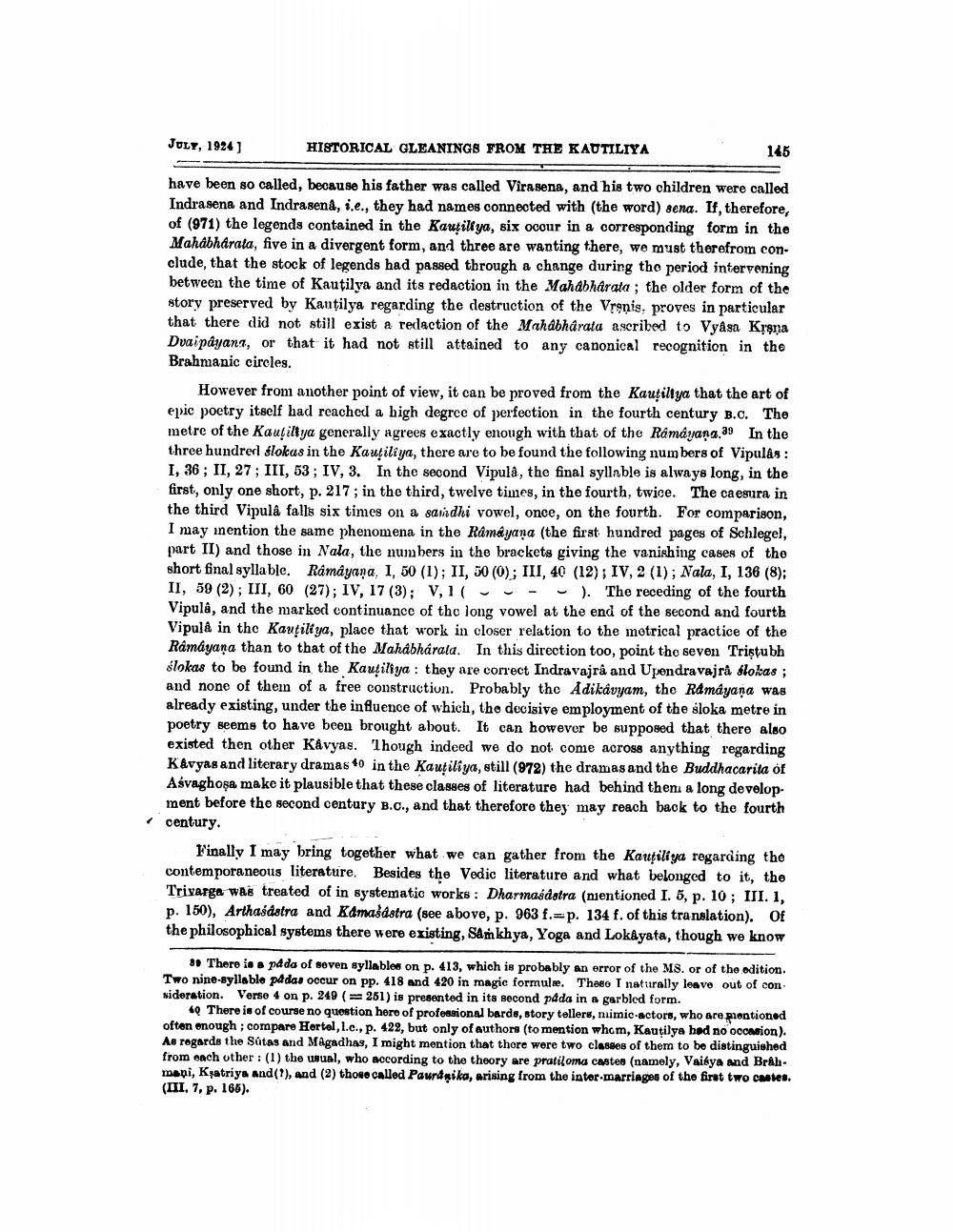________________
JULY, 1924)
HISTORICAL GLEANINGS FROM THE KAUTILIYA
145
have been so called, because his father was called Virasena, and his two children were called Indrasena and Indrasena, i.e., they had names connected with the word) sena. If, therefore, of (971) the legends contained in the Kautiliya, six ooour in a corresponding form in the Mahabharata, five in a divergent form, and three are wanting there, we must therefrom conclude, that the stock of legends had passed through a change during the period intervening between the time of Kautilya and its redaction in the Mahabharata ; the older form of the story preserved by Kautilya regarding the destruction of the Vrsnis, proves in particular that there did not still exist a reaction of the Mahabharata ascribed to Vyâsa Krona Dvai payant, or that it had not still attained to any canonical recognition in the Brahmanic circles.
However from another point of view, it can be proved from the Kautilya that the art of epic poetry itself had reached a high degree of perfection in the fourth century B.C. The metre of the Kauçiltya generally agrees exactly enough with that of the Ramayana.39 In the three hundred flokus in the Kauçiliya, there are to be found the following numbers of Vipulás: I, 36 ; II, 27; III, 53 ; IV, 3. In the second Vipula, the final syllable is always long, in the first, only one short, p. 217; in the third, twelve times, in the fourth, twice. The caesura in the third Vipula falls six times on a saindhi vowel, once, on the fourth. For comparison, I may inention the same phenomena in the Ramayana (the first hundred pages of Schlegel, part II) and those in Nala, the numbers in the brackets giving the vanishing cases of the short final syllable. Ramayana, I, 50 (1); II, 50 (0); III, 40 (12); IV, 2 (1); Nala, I, 136 (8); II, 59 (2); III, 60 (27); IV, 17 (3); V, 1( - - ). The receding of the fourth Vipulâ, and the marked continuance of the long vowel at the end of the second and fourth Vipul& in the Kautillya, place that work in closer relation to the motrical practice of the Ramayana than to that of the Mahabharala. In this direction too, point the seven Triştubh ślokas to be found in the Kauçiliya : they are correct Indravajra and Upendravajrå slokas; and none of them of a free construction. Probably the Adikávyam, the Ramayana was already existing, under the influence of which, the decisive employment of the sloka metre in poetry seems to have been brought about. It can however be supposed that there also existed then other Kavyas. Though indeed we do not come across anything regarding Kavyas and literary dramas 10 in the Kautiliya, still (972) the dramas and the Buddhacarita of Ašvaghoşa make it plausible that these classes of literature had behind then a long develop ment before the second century B.C., and that therefore they may reach back to the fourth century.
Finally I may bring together what we can gather from the Kaufiliya regarding the contemporaneous literature. Besides the Vedic literature and what belonged to it, the Triyarga was treated of in systematic works : Dharmasdatra (nientioned I. 5, p. 10; III. 1, p. 150). Arthasdatra and Kamasastra (see above, p. 963 f. p. 134 f. of this translation). Of the philosophical systems there were existing, Sankhya, Yoga and Lokayata, though we know
There is a pada of soven syllables on p. 413, which is probably an error of the MS, or of the edition. Two nine-syllable padas occur on pp. 418 and 420 in magic formulie. Theo T naturally leave out of con sideration. Verso 4 on p. 249 ( 261) is presented in its second pdda in & garbled form.
40 There is of course no question hero of professional bards, story tellers, nimic actors, who are prentioned ofton enough ; compare Hertel, 1.c., p. 422, but only of authors (to mention whcm, Kautilya bød no occasion). As regards the Sutas and Magadhas, I might mention that there were two classes of them to be distinguished from each other: (1) the usual, who according to the theory are pratiloma casten (namely, Vaibya and Brahmani, Ksatriya and(1), and (2) thoso called Paurdnika, arising from the inter-marriages of the first two chalet. (III, 7, p. 166).




